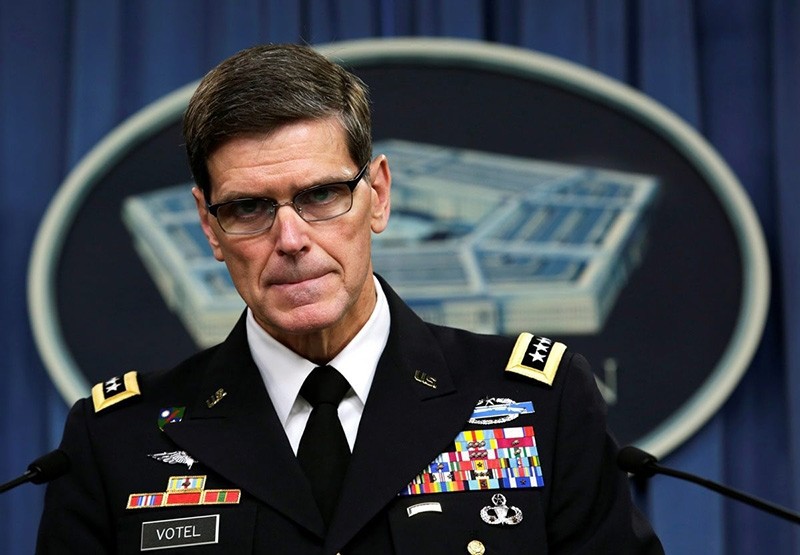
The top American commander for the Middle East wants a more aggressive Afghan military pressuring Taliban and other insurgents over the normally quieter months of Afghanistan's winter, and then quickly going on the offensive in the spring. It's all part of a plan the United States hopes will change the course of a war now entering its 17th year.
Gen. Joseph Votel of U.S. Central Command said an influx of new American trainers can help escalate the fight. They'll be operating with Afghan units, closer to the front lines and at greater risk, but Votel said U.S. commanders will ensure American and allied forces have adequate protection.
The goal is to get the Afghan military moving on its military campaign sooner, rather than later.
The United States wants the "focus on offensive operations and we'll look for a major effort to gain the initiative very quickly as we enter into the fighting season," Votel said in a recent interview with The Associated Press.
Afghan forces must "keep the pressure on all the time and work to gain the upper hand as quickly as we can. So that as we get into this next fighting season we can build on the initiative," he said.
The Trump administration's Afghanistan strategy gives the U.S. military greater authority to launch offensive attacks against a resilient Taliban and an emerging Daesh affiliate. The plan, announced in August, was designed to reverse a stalemate in America's longest war. It specifically eliminates the Obama administration's scheduled plan to withdraw U.S. forces, but includes no dramatic changes in an approach that has failed to stabilize the country or snuff out terrorist groups operating from Afghan territory.
As 2018 begins, Afghanistan appears to be high on President Donald Trump's agenda. On New Year's Day, he slammed Afghanistan's neighbor Pakistan in a tweet for "lies & deceit," accusing the country of playing U.S. leaders for "fools" by not crushing militants in its territory. A major focus of Trump's Afghanistan strategy is to persuade Pakistan to eliminate havens for the Taliban and other terrorists.
Pakistan summoned the U.S. ambassador and Islamic groups held rallies in major Pakistani cities in response.
On the Afghan side of the border, Washington is trying to build a tougher national military.
Votel said as the coalition builds up the Afghan Air Force and trains more security forces, the Afghans will become better fighters. "By the time they get to the next fight," he said, "they will be able to really present a significant offensive capability."
But it's hardly the first time the American military has vowed to shape up the U.S.-backed army into a force that can defeat the Taliban, al-Qaida, Daesh and others. Nor does Trump's approach represent the first time a frustrated president has pumped troops into the country to turn the situation around. There are now as many as 16,000 U.S. forces in the country — roughly double what Trump inherited — and a special training unit is scheduled to deploy to Afghanistan early this year.
When then-President Barack Obama took office in 2009, he authorized a surge of U.S. forces to Afghanistan that took the total there to about 100,000. The goal was to tamp down a resurgent Taliban and train and expand Afghan security forces. The plan centered on forcing the Taliban to the peace table and ending the war by the time Obama left office.
The plan never worked, despite the mission meeting several celebrated benchmarks: Obama ended combat operations in 2014, curtailed offensive strikes and set deadlines for a full U.S. troop withdrawal. And as the U.S. and NATO forces pulled back, the Taliban stepped up attacks and regained ground, while a Daesh faction carved out its own foothold. Obama ended his presidency leaving more than 8,000 U.S. forces in Afghanistan.
Beyond boosting troop numbers, Trump has granted his generals' wishes for fewer combat restrictions, greater authority for commanders and no withdrawal deadline.
Next year will be the first test of the policy. The Taliban currently controls as much as half of the country.
James Stavridis, a retired Navy admiral who served as the top U.S. commander for NATO from 2009 until 2013, said the ultimate goal in Afghanistan remains the same: Pushing the Taliban into seeking peace negotiations.
"There is a slightly better than even chance that there are some new factors which move us toward the possibility of a successful outcome," said Stavridis, now dean of The Fletcher School of Law and Diplomacy at Tufts University. Those changes, he said, include the elimination of troop withdrawal timelines and Taliban fatigue.
"I think they're tired, too. This is also a 17 year war for them," Stavridis said, but suggested any settlement will require compromise. "Is this going to be a sweeping victory? No. But I think the odds are much higher of getting them to the negotiating table."
Votel, too, said he believes efforts are trending in the right direction, as Afghanistan's military replaces older commanders with younger officers. Recruitment is being maintained at a rapid pace.
But as winter arrives, Votel said the Afghan army must stay on the offense and prepare for greater fighting once the weather improves.
"We frequently talk about these fighting seasons, but as you know the fighting never actually ends," Votel said.
